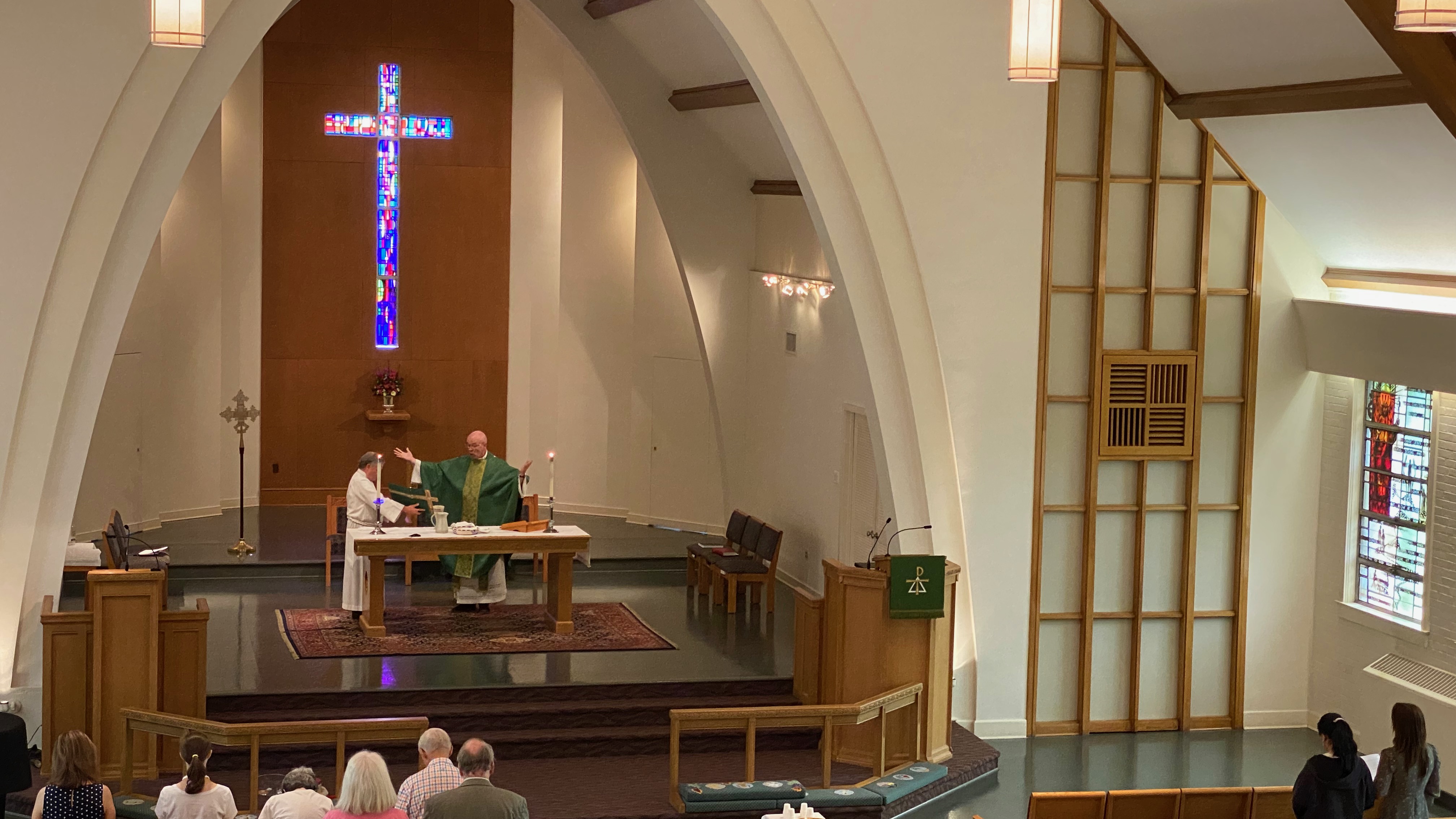Week of the Festival of Pentecost
Dear Friends in Christ:
Many of you have read and are wondering about the recent article in the Washington Post concerning the controversy in one of our ELCA synods in California. I plan to write about this next week when I know more after having attended our Metro DC Synod Assembly this coming weekend.
Meanwhile, we will celebrate the festival of the Holy Trinity this coming Sunday, the First Sunday after Pentecost. Thus, I am moved to offer reflections this week on our Trinitarian understandings of God.
First off, the doctrine of the Holy Trinity – the teaching that there is one God, and three distinct persons of the Godhead, Father, Son, and Holy Spirit – does not explicitly appear as a concept in the bible. That said, there is plenty in the scriptures which point in the direction of Trinitarian understandings and which formed the foundations for the evolution of Christian thought toward Trinitarian doctrine.
Here are some of the important biblical passages which suggest Trinitarian possibilities:
John 1:1-18, the Prologue to John’s Gospel, proclaims that the divine Word who was made flesh in Jesus Christ was at the beginning with God and was in fact God.
Genesis 1:1-2, the first creation story, speaks of a wind or spirit from God that swept over the face of the waters to bring created order from chaos. When this story is read in connection with John’s Gospel, we may begin to see hints of the Trinity.
Then there are a number of other passages in the Gospel of John appointed for Eastertide in Lectionary year C which are suggestive of Trinitarian understandings. John was written perhaps three generations after Jesus’ earthly sojourn, thus offering us the vantage point of seeing the evolution of theological thinking among early Christians. So, there’s John 10:30, where John reports that Jesus said, “The Father and I are one.” And there’s John 14:9-11 where John reports Jesus saying to Philip, “Whoever has seen me has seen the Father…. Believe me that I am in the Father and the Father is in me.” Moreover, there’s John 16:12-15, which we’ll hear this coming Trinity Sunday, which concludes with these words of Jesus reported by John which described for the disciples the coming of the Holy Spirit: “All that the Father has is mine. For this reason I said that the Spirit will take what is mine and declare it to you.” Finally, there’s the Pentecost event recorded in John 20:21-23, “‘As the Father has sent me, so I send you.’ When he had said this, he breathed on them and said to them, ‘Receive the Holy Spirit…’” John’s Gospel is, thus, rich with evocations of the beginnings of Trinitarian thought.
Matthew 28:19, the Great Commission, gives us the Trinitarian words we use to this day at baptism: “Go therefore and make disciples of all nations, baptizing them in the name of the Father and of the Son and of the Holy Spirit…”
Then there are Trinitarian aspects of the stories of Jesus’ baptism by John in the River Jordan. Matthew 3:16-17, Mark 1:10-11, and Luke 3:21-22 variously report God proclaiming Jesus as a favored Son while the Holy Spirit from God descends on Jesus.
Acts 2:32-33, a moment in Peter’s first sermon proclaiming God’s deeds of power in raising Jesus from the dead, offers Trinitarian hints: “This Jesus God raised up, and of that all of us are witnesses. Being therefore exalted at the right hand of God, and having received from the Father the promise of the Holy Spirit, he has poured out this that you both see and hear."
Then there are the Pauline greetings that are liturgically quite familiar to us which are suggestive of the Trinity. 2 Corinthians 13:13, which concludes that letter, has these well-known words: “The grace of the Lord Jesus Christ, the love of God, and the communion of the Holy Spirit be with you all.”
Ephesians 2:18 offers this insight: “for through [Christ] both of us [Jewish and Gentile believers] have access in one Spirit to the Father.” Here, like many New Testament passages, the three persons of the Godhead are mentioned.
A great Christ hymn in Colossians (cf. 1:15-17) echoes themes found in the prologue to John. There in Colossians it reads, Christ “is the image of the invisible God, the firstborn of all creation; for in him all things in heaven and on earth were created, things visible and invisible, whether thrones or dominions or rulers or powers – all things have been created through him and for him. He himself is before all things, and in him all things hold together.” Colossians 1:19 concludes, “For in [Christ] all the fullness of God was pleased to do dwell.” In this hymn, which also sounds creedal, we see perhaps the beginnings of explicitly Trinitarian thinking.
Finally, salutations to believers recorded in 1 Peter 1:2 offer Trinitarian themes as it is there written: “To the exiles… who have been chosen and destined by God the Father and sanctified by the Spirit to be obedient to Jesus Christ and to be sprinkled with his blood: May grace and peace be yours in abundance.”
This review of the scriptural witness, which arguably contributed to what would later be understood as the Trinity, is not comprehensive or exhaustive. There’s more in the bible that we could point to and explore in relation to Trinitarian themes. And it is essential to say that none of these scriptural passages add up in a simple kind of math equation to the doctrine of the Holy Trinity, one God in three persons. That nuanced and paradoxical understanding would evolve over the course of the next decades and generations of Christian history as the church itself came to be and to develop. But I believe it is true that the scriptural witness laid a solid foundation for what would become our Trinitarian understanding of God as Father, Son, and Holy Spirit.
Thus, we have the Athanasian Creed (likely dating from the 5th Century) which arguably articulates best, at least in authoritative creedal form, the Christian understanding of the Trinity. Here is a portion of that ancient creed: “Now this is the catholic faith: We worship one God in trinity and the Trinity is unity, neither confusing the persons nor dividing the divine being. For the Father is one person, the Son is another, and the Spirit is still another. But the deity of the Father, Son, and Holy Spirit is one, equal in glory, coeternal in majesty.” And on and on this creed goes, exploring the many paradoxical convolutions of our Trinitarian understandings.
The evolution of Christian thought and understanding is itself a work, I believe, of the Holy Trinity. John reports that Jesus said (and we’ll likewise hear this later this week on Trinity Sunday):
“I still have many things to say to you, but you cannot bear them now. When the Spirit of truth comes, you will be guided into all the truth; for the Spirit will not speak out of the Spirit’s own authority, but will speak whatever the Spirit hears, and will declare to you the things that are to come.” (John 16:12-13) Teaching about the Holy Trinity is one such truth into which we have been guided.
As has been the case throughout Christian history, the Holy Spirit, whom we confess proceeds from the Father and the Son, continues to guide us into all truth, including the truth about the Trinitarian nature of the God who creates, redeems, sanctifies, and more and more – all in a wonderful, sometimes baffling, paradoxical mystery and wondrous dance.
How can we respond and conclude but in words of poetic praise of the Trinity, here in a text of unknown source, translated by Clarence Walworth, the concluding stanza of “Holy God, We Praise Your Name” (ELW 414): “Holy Father, holy Son, Holy Spirit, three we name you, though in essence only one; undivided God we claim you and, adoring, bend the knee while we own the mystery.”
Pastor Jonathan Linman






